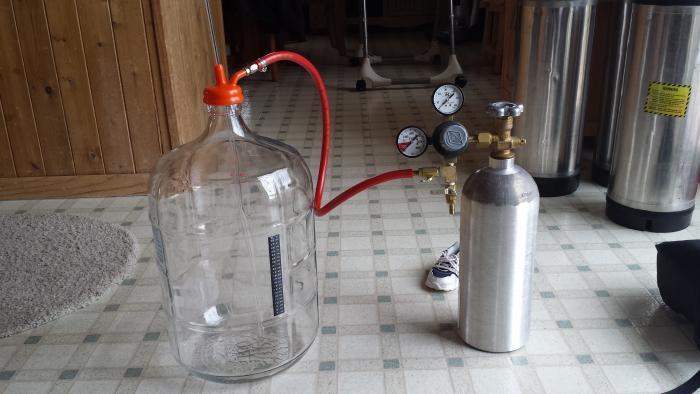I'm sure someone has already did this but thought I'd post a pic, I can post a parts list if anyone wants it..works like a champ, and no more chance of oxidizing. .straight from the fermentor to the keg...




Does this add any carb. to the beer while transferring it over? I would love to do this less mess setup and I have0 the Co2 tank and hoses, just never thought of it.
I'd like to read more on it and see a parts list. Do you put a hose on the other side of the carboy cap and rack to the keg from that?
Any way to do it with a bucket?
A guy in our homebrew club just did a presentation on transferring from the carboy to the keg without ever exposing the beer to oxygen. He uses this method, and pushes the beer into the liquid port of the keg, which has been filled with CO2. On the gas side, he just has a gas connection hooked up so it lets the CO2 out while the beer flows in. He also uses a scale to measure when he reaches 5 gallons, but that's a whole different discussion... The point is, he never has to open the keg, and if he's storing a beer for a really long time, he never worries about oxydation since the beer has never been exposed to oxygen.
Just put gamma lids on all of my buckets and was thinking about converting one with a gas powered siphon. May have to head to Homey's to figure it out.
Is oxidation when transferring from fermenter to keg that big a deal? It' s not like I'm splashing my beer around when transferring. Once the beer starts siphoning, the hose is under water so to speak. Just curious whether this is worth going to the trouble.
The CO2, being heavier than air creates a blanket over the beer. The only real potential source for oxidation would/should be leaks in the siphon tubing or excessive splashing.
Is oxidation when transferring from fermenter to keg that big a deal? It' s not like I'm splashing my beer around when transferring. Once the beer starts siphoning, the hose is under water so to speak. Just curious whether this is worth going to the trouble.
If you do test it with a bucket, please let us know how it works. I would love to start transferring this way
Is oxidation when transferring from fermenter to keg that big a deal? It' s not like I'm splashing my beer around when transferring. Once the beer starts siphoning, the hose is under water so to speak. Just curious whether this is worth going to the trouble.
Funny , I was thinking the same thing. I purge my kegs w / CO2 before racking from my carboy using an Auto-Siphon. The CO2, being heavier than air creates a blanket over the beer. The only real potential source for oxidation would/should be leaks in the siphon tubing or excessive splashing.
Sent from my iPhone using Home Brew
I'm not sure that purging your keg with CO2 before transfer is really adding any benefit. After all, people who bottle their beer don't "purge" their bottling bucket before transferring the beer into it - they just rack it straight in, then bottle, and bottled beer isn't all oxidized, is it?
Secondly, let me save you some searching down the road and just give you a link that should come in handy eventually.
the argument is that there's more head space in the keg than in an individual bottle, so purging the oxygen out of a keg would reduce the risk.
You can also use a 5/16" ID tube, attach that to the racking cane and use a beer (blk) Keg disconnect and go straight into the keg (the beer out port) without even opening the keg. Just be sure to open the relief valve on the keg during transfer.
I feel the need to reiterate, just for my own sake. Don't get me wrong, people can do whatever they want.
I used to do this. Altho I didn't have a fancy hookup, I just un-screwed a ball-lock fitting and pushed the open end on the inlet of the carboy cap. Anyway, one day i turned the gas on and "POP"! I flinched and froze thinking i just blew up the carboy. Luckily only the cap popped off.
Hindsight is 20/20 but deliberately and intentionally pressurizing a glass carboy using a regulator not designed for this level of accuracy is quite frankly the dumbest thing I can possibly think of in the realm of homebrewing. And yes - I realize i'm guilty as charged.
I'm not sure that purging your keg with CO2 before transfer is really adding any benefit. After all, people who bottle their beer don't "purge" their bottling bucket before transferring the beer into it - they just rack it straight in, then bottle, and bottled beer isn't all oxidized, is it?
Secondly, let me save you some searching down the road and just give you a link that should come in handy eventually.
Enter your email address to join: